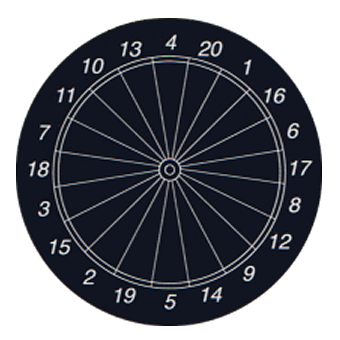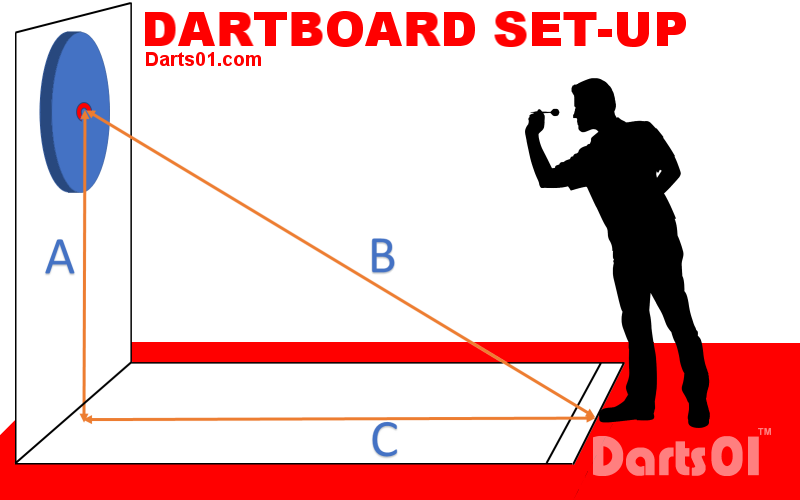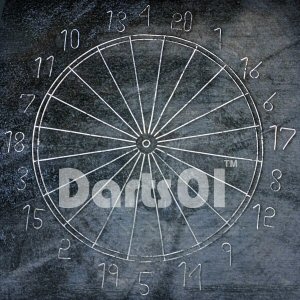Manchester Dartboard
Manchester Log-end - Regional Dartboard
The Manchester or 'Log-End' dartboard is unique by today's modern standards. This board is handmade, double-sided and made from wood. It was made using UK Elm; however, the UK suffered from the spread of Dutch Elm Disease that wiped out millions of Elms by the mid-1970s. Other woods, like Poplar/Tulipwood, have also been used to make the board.
The Manchester Log-end Dartboard is said to be the hardest dartboard to play on due to its small playing area. The dartboards are dyed jet black and only measure 10 inches (254mm) in diameter (wire to wire). The doubles are 5mm wide. Hence the difficulty, as these are hard to hit.
The Manchester Log-end Dartboard is still played upon in some parts of Manchester today. However, until recently, there seemed to be only one person still making them, Dave Mealey. However, David sadly died in 2023. His son Chris has now taken up the baton and continues making the dartboard in the traditional fashion.
When I had the pleasure of speaking to David, he informed me he made up to 400 dartboards annually, all by hand. The dartboard has a unique numbering system and is quite different from the standard 'clock' / 'London' dartboard most of us have played on and seen on TV. Although there are still 20 segments numbered 1-20 with an inner and outer bullseye, plus a double ring, the order of the numbers is different from any other dartboard.

Besides the inner and outer bullseye the only number that features in the same place as a standard ‘Clock’ dartboard is ‘19’. The order going from centre top clockwise is as follows:
| Manchester Dartboard | 4 | 20 | 1 | 16 | 6 | 17 | 8 | 12 | 9 | 14 | 5 | 19 | 2 | 15 | 3 | 18 | 7 | 11 | 10 | 13 |
| Standard Dartboard | 20 | 1 | 18 | 4 | 13 | 6 | 10 | 15 | 2 | 17 | 3 | 19 | 7 | 16 | 8 | 11 | 14 | 9 | 12 | 5 |
The boards are dyed jet black to easily see the embedded metal scoring segment dividers and numbers. The board must also be immersed in water when not in use. Otherwise, the board will dry out and split. Remove the board from the water an hour or two before play.
It used to take Dave about two hours to make each board, but how long will the Manchester board be commercially available may now depend on David Mealey's son Chris, unless others wish to make them.
Due to the nature of how the Manchester Log-end Dartboard is made, supply is difficult to find. The boards need to be kept wet. When New, the boards are supplied damp and wrapped in thick plastic film to keep the moister from evaporating as much as possible.
![]()
Manchester 'Log-end' Dartboard Set-up and Rules:
Dartboard Setup
The dartboard should hang securely from a wall so that the height of the centre bull is 5ft 3ins / 161cm* from the floor. The toe-line or Oche 7ft 6ins / 229 cm shall be clearly marked and should be at least 18ins long. The toe line can be just a painted line on the ground or a securely raised line indicator such as a piece of wood or metal. The latter is preferable as the thrower has firm edge to rest his/her foot against.
* The height of the board can vary depending on the Manchester league. Some leagues set the board height at 5’6” although the throwing distance remains the same.
The order of play is either determined by a toss of a coin or by each player throwing for the centre bull the nearest being the player that throws first. The rules here can vary depending on the league you may be playing in; the local rules should be observed at all times.
| A: Height to Centre Bull | B: Centre Bull to Oche | C: Throw Distance |
| 5ft 3ins / 1.61m | 9ft 2ins / 2.79m | 7ft 6ins / 2.29m |
| * 5ft 6ins / 1.68m | 9ft 3 1/5ins / 2.84m | 7ft 6ins / 2.29m |

* Dartboard height can vary within the Manchester leagues.
Usually the hight is set at 5ft 3ins or 5ft 6ins”
I am pleased to say John Gwynne has confirmed the official height as 5’3”
![]()
Manufacturer / Supplier of the Manchester Log-end Dartboard
Manchester Log-end dartboards are handcrafted, and only a few have made and sold these successfully. As the name suggests, the dartboard is made from a tree trunk (Log-end) and is not a flat-ply dartboard from which some American-style dartboards are made. Over the years, the wood used has varied, initially Elm, but alternative woods have been used due to the outbreak of Dutch Elm disease, which destroyed the main supply in the UK.
For many years, Perrio Darts in Manchester made and supplied the dartboard. However, the supply was discontinued following the owner's and maker's retirement.
David Mealy took up the mantle to continue to make and supply the dartboard for the Manchester Log-end league. David supplied some shops, notably Treble Darts and Trophies, in Oldham until its closure in 2022. David continued to supply the Manchester Log-end dartboard until his unfortunate death in 2023.
David's son Chris continues his late father's work and supplies the Manchester Log-end League and the general public with this unique handcrafted dartboard.
Chris Mealey (Maker and Supplier of the Manchester Log-end Dartboard)
Chris has also informed me that the Manchester Log-end dartboards his late father and he now make are Square and not the traditional circular version. (the playing area is unchanged).
Chris sighted board supply issues, and previous providers have since closed.
A picture of the Squiare version is shown here.
You can contact Chris On (+44) (0) 7946 426064
Email: DJ Dominoes Logends

The contact details of another maker that still makes the traditional round version will be published with permission shortly. (Pending NOV 2023)
If you know of any other supplier of the Manchester dartboard please let me know. Contact.
John Gwynn referes a match on the Manchester Log-end Dartboard. The short video also features some well known faces.
View this video on YouTube
![]()
Standard Game - Rules
The standard Manchester dartboard game is to hit in order numbers 1 to 20 and at least one double before hitting the Bullseye (inner or outer). Please read on…
Each player throws in turn. If number one is hit with the first dart, they progress to number two. If the player should hit the double of the number they are throwing for, then they progress to the number exceeding the value of that double (if possible). Hitting double one (2) when throwing for one moves the player to number three. Should the player hit double three when throwing for three (6), they move straight to number seven. Once all the numbers have been hit, the first double the player hit must be hit again before hitting the centre bullseye. If no double was hit during the progress around the board, then the player must hit double 20 before hitting the Bullseye.
In the case of this game, the Bullseye and outer Bullseye both count as a single target. It isn’t uncommon for the centre bullseye to be removed. However, doing so prevents a 301 game from being played fully.
See local league rules for further information.
301 - Rules
Generally, each player's score must start and finish a game with a double (The narrow outer ring of the board). Competition games, however, are usually played with a straight start (no compulsory double) but with a compulsory double to finish.
The first throw is deducted from the player's start number, e.g. 301 and then from the reduced total. The scorer should show the score obtained for the throw and the reduced total remaining.
The inner Bullseye (50) counts as double (25) the outer Bullseye.
Also, see your local league rules for further information.
Acknowledgements | Privacy, Cookies & Terms of Use | FAQ


